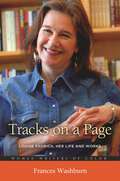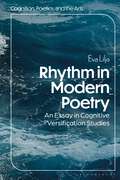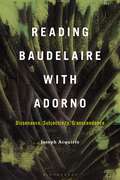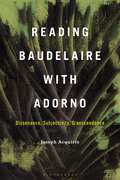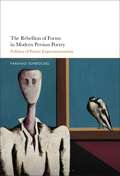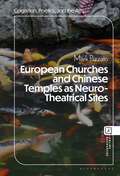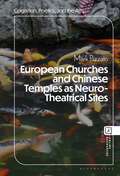- Table View
- List View
Tracks on a Page: Louise Erdrich, Her Life and Works (Women Writers of Color)
by Frances WashburnThis book details the intersections between the personal life and exceptional writing of Louise Erdrich, perhaps the most critically and economically successful American Indian author ever.Known for her engrossing explorations of Native American themes, Louise Erdrich has created award-winning novels, poetry, stories, and more for three decades. Tracks on a Page: Louise Erdrich, Her Life and Works examines Erdrich's oeuvre in light of her experiences, her gender, and her heritage as the daughter of a Chippewa mother and German-American father.The book covers Erdrich from her birth to the present, offering fresh information and perspectives based on original research. By interweaving biography and literary analysis, the author, who is herself Native American, gives readers a complete and nuanced understanding of the ways in which Erdrich's identity as a woman and an American Indian have influenced her life and her writing. Tracks on a Page is the first, book-length work to approach Erdrich and her works from a non-Euro-Western perspective. It contextualizes both life and writing through the lenses of American Indian history, politics, economics, and culture, offering readers new and intriguing ways to appreciate this outstanding author.
Rhythm in Modern Poetry: An Essay in Cognitive Versification Studies (Cognition, Poetics, and the Arts)
by Professor Emerit Eva LiljaA pioneering work in cognitive versification studies, scrutinizing the rhythmical means of free verse.Investigating a previously neglected area of study, Rhythm in Modern Poetry establishes a foundation for cognitive versification studies with a focus on the modernist free verse. Following in the tradition of cognitive poetics by Reuven Tsur, Richard Cureton and Derek Attridge, every chapter investigates the rhythms of one modern poem, by Lawrence Ferlinghetti, Sylvia Plath and others, and engages each element in the broader interpretation of the poem in question. In her examination of modernist poetry in English and other Germanic languages, Eva Lilja expands her analysis to discuss both the Ancient Greek and Norse origins of rhythm in free verse and the intermedia intersection, comparing poetic rhythm with rhythm in pictures, sculptures and dance. Rhythm in Modern Poetry thus expands the field of cognitive versification studies while also engaging readers writ large interested in how rhythm works in the aesthetic field.
Reading Baudelaire with Adorno: Dissonance, Subjectivity, Transcendence
by Joseph AcquistoReading Baudelaire with Adorno examines Charles Baudelaire's oeuvre – including verse poems, prose poems, and critical writings – in dialogue with the aesthetic theory of Theodor Adorno, for whom the autonomy of the artwork critically resists any attempt to view it merely as a product of its socio-historic context. Joseph Acquisto analyzes Baudelairean duality through the lens of dissonance, arguing that the figure of the subject as a “dissonant chord” provides a gateway to Baudelaire's reconfiguration of subjectivity and objectivity in both esthetic and epistemological terms. He argues that Baudelaire's dissonance depends on older models of subjectivity in order to define itself via the negation of romantic conceptions of a unified lyric subject in favor of one constituted simultaneously as subject and object.This new understanding of subjectivity reconfigures our relationship to the work of art, which will always surpass conceptual attempts to know it fully. Acquisto offers a fresh take on some familiar themes in Baudelaire's work. Dissonant subjectivity in Baudelaire, rather than cancelling esthetic transcendence, points to a different way forward that depends on a new and dialectical relation of subject and object.
Reading Baudelaire with Adorno: Dissonance, Subjectivity, Transcendence
by Joseph AcquistoReading Baudelaire with Adorno examines Charles Baudelaire's oeuvre – including verse poems, prose poems, and critical writings – in dialogue with the aesthetic theory of Theodor Adorno, for whom the autonomy of the artwork critically resists any attempt to view it merely as a product of its socio-historic context. Joseph Acquisto analyzes Baudelairean duality through the lens of dissonance, arguing that the figure of the subject as a “dissonant chord” provides a gateway to Baudelaire's reconfiguration of subjectivity and objectivity in both esthetic and epistemological terms. He argues that Baudelaire's dissonance depends on older models of subjectivity in order to define itself via the negation of romantic conceptions of a unified lyric subject in favor of one constituted simultaneously as subject and object.This new understanding of subjectivity reconfigures our relationship to the work of art, which will always surpass conceptual attempts to know it fully. Acquisto offers a fresh take on some familiar themes in Baudelaire's work. Dissonant subjectivity in Baudelaire, rather than cancelling esthetic transcendence, points to a different way forward that depends on a new and dialectical relation of subject and object.
The Rebellion of Forms in Modern Persian Poetry: Politics of Poetic Experimentation
by Dr. Farshad SonboldelAn analysis of the aesthetic, cultural and political aspects of alternative poetic movements and individual poets in three periods: the Constitutional Revolution (1900–1920), the post-constitutional era (1920–1940), and the ascendency of modernism (1940–1960). Farshad Sonboldel shines new light on the history of modern Persian poetry by re-imagining the roles that the aesthetic experimentations of alternative poets played in different phases of the literary revolution in modern Persian poetry. Dominant narratives portray modern Persian poetry as a gradual, rational, and moderate change in the classical regime of aesthetics as well as a response to – and reflection of – cultural and socio-political changes within Iranian society. They also disregard the significance of radical experiments by alternative poets and undervalue the part they played in the initiation and progress of the so-called "literary revolution." These mainstream narratives minimize the socio-political engagement of literary works with the direct reflection of the social reality, and thus neglect the way many alternative poems struggle with socio-political issues through deconstructing the old and constructing new aesthetic systems.Each chapter of The Rebellion of Forms in Modern Persian Poetry is centred around poems chosen for their potential to showcase notable experiments of pioneer movements and individuals in each given period. Examining the formal and thematic aspects of these poems, this book reformulates the story of modern Persian poetry and unravels the relationship between radical aesthetic changes in the practice of poetry and resistance against political and cultural domination in society.
The Rebellion of Forms in Modern Persian Poetry: Politics of Poetic Experimentation
by Dr. Farshad SonboldelAn analysis of the aesthetic, cultural and political aspects of alternative poetic movements and individual poets in three periods: the Constitutional Revolution (1900–1920), the post-constitutional era (1920–1940), and the ascendency of modernism (1940–1960). Farshad Sonboldel shines new light on the history of modern Persian poetry by re-imagining the roles that the aesthetic experimentations of alternative poets played in different phases of the literary revolution in modern Persian poetry. Dominant narratives portray modern Persian poetry as a gradual, rational, and moderate change in the classical regime of aesthetics as well as a response to – and reflection of – cultural and socio-political changes within Iranian society. They also disregard the significance of radical experiments by alternative poets and undervalue the part they played in the initiation and progress of the so-called "literary revolution." These mainstream narratives minimize the socio-political engagement of literary works with the direct reflection of the social reality, and thus neglect the way many alternative poems struggle with socio-political issues through deconstructing the old and constructing new aesthetic systems.Each chapter of The Rebellion of Forms in Modern Persian Poetry is centred around poems chosen for their potential to showcase notable experiments of pioneer movements and individuals in each given period. Examining the formal and thematic aspects of these poems, this book reformulates the story of modern Persian poetry and unravels the relationship between radical aesthetic changes in the practice of poetry and resistance against political and cultural domination in society.
European Churches and Chinese Temples as Neuro-Theatrical Sites (Cognition, Poetics, and the Arts)
by Prof. or Dr. Mark PizzatoCompares monumental designs and performance spaces of Christian, Buddhist, and related sanctuaries, exploring how brain networks, animal-human emotions, and cultural ideals are reflected historically and affected today as "inner theatre" elements. Integrating research across the humanities and sciences, this book explores how traditional designs of outer theatrical spaces left cultural imprints for the inner staging of Self and Other consciousness, which each of us performs daily based on how we think others view us. But believers also perform in a cosmic theatre. Ancestral spirits and gods (or God) watch and interact with them in awe-inspiring spaces, grooming affects toward in-group identification and sacrifice, or out-group rivalry and scapegoating. In a study of over 80 buildings – shown by 40 images in the book, plus thousands of photos and videos online – Pizzato demonstrates how they reflect meta-theatrical projections from prior generations. They also affect the embodied, embedded, enacted, and extended (4E) cognition of current visitors, who bring performance frameworks of belief, hope, and doubt to the sacred site. This involves neuro-social, inner/outer theatre networks with patriarchal, maternal, and trickster paradigms. European Churches and Chinese Temples as Neuro-Theatrical Sites investigates performative material cultures, creating dialogs between theatre, philosophy, history, and various (cognitive, affective, social, biological) sciences. It applies them to the architecture of religious buildings: from Catholic, Orthodox, and Protestant in Europe, plus key sites in Jerusalem and prior “pagan” temples, to Buddhist, Daoist, Confucian, and imperial in China. It thus reveals individualist/collectivist, focal/holistic, analytical/dialectical, and melodramatic/tragicomic trajectories, with cathartic poetics for the future.
European Churches and Chinese Temples as Neuro-Theatrical Sites (Cognition, Poetics, and the Arts)
by Prof. or Dr. Mark PizzatoCompares monumental designs and performance spaces of Christian, Buddhist, and related sanctuaries, exploring how brain networks, animal-human emotions, and cultural ideals are reflected historically and affected today as "inner theatre" elements. Integrating research across the humanities and sciences, this book explores how traditional designs of outer theatrical spaces left cultural imprints for the inner staging of Self and Other consciousness, which each of us performs daily based on how we think others view us. But believers also perform in a cosmic theatre. Ancestral spirits and gods (or God) watch and interact with them in awe-inspiring spaces, grooming affects toward in-group identification and sacrifice, or out-group rivalry and scapegoating. In a study of over 80 buildings – shown by 40 images in the book, plus thousands of photos and videos online – Pizzato demonstrates how they reflect meta-theatrical projections from prior generations. They also affect the embodied, embedded, enacted, and extended (4E) cognition of current visitors, who bring performance frameworks of belief, hope, and doubt to the sacred site. This involves neuro-social, inner/outer theatre networks with patriarchal, maternal, and trickster paradigms. European Churches and Chinese Temples as Neuro-Theatrical Sites investigates performative material cultures, creating dialogs between theatre, philosophy, history, and various (cognitive, affective, social, biological) sciences. It applies them to the architecture of religious buildings: from Catholic, Orthodox, and Protestant in Europe, plus key sites in Jerusalem and prior “pagan” temples, to Buddhist, Daoist, Confucian, and imperial in China. It thus reveals individualist/collectivist, focal/holistic, analytical/dialectical, and melodramatic/tragicomic trajectories, with cathartic poetics for the future.
Rediscovering Rubén Darío through Translation
by Dr. Carlos F. GrigsbyA long overdue examination of Rubén Darío's multilingual work and influences alongside the contexts and politics of canonization in world literature. Rediscovering Rubén Darío through Translation addresses the peculiar obscurity of Darío by asking these questions: How can one of the most important writers of a major world language be almost entirely unknown in the English-speaking world? How is it that other writers of the same language (e.g., Lorca or García Márquez) achieve widespread recognition in the anglophone world, while he remains unnoticed? What role does translation play in this? What can it tell us about the way in which world literature is articulated? Carlos F. Grigsby approaches Darío's oeuvre through translation. In doing so, he explores not only the place of Darío in the translation of Spanish American literature into English, but also the place of translation in Darío's own writing. The result is a double-sided painting, as it were: the recto is titled “Translation in Darío” and the verso “Darío in Translation.” This book challenges the field of world literature by revealing some of the biases present in its representation of Spanish American literature. It adopts a multilingual framework – chiefly using English, Spanish, French, and to a lesser degree Latin and Catalan – in analyzing Darío's writing alongside that of his contemporaries. As a result, it reveals the multilingualism of Darío's own writing, opening new avenues for the study of his work and of Spanish American modernismo more generally.
Rediscovering Rubén Darío through Translation
by Dr. Carlos F. GrigsbyA long overdue examination of Rubén Darío's multilingual work and influences alongside the contexts and politics of canonization in world literature. Rediscovering Rubén Darío through Translation addresses the peculiar obscurity of Darío by asking these questions: How can one of the most important writers of a major world language be almost entirely unknown in the English-speaking world? How is it that other writers of the same language (e.g., Lorca or García Márquez) achieve widespread recognition in the anglophone world, while he remains unnoticed? What role does translation play in this? What can it tell us about the way in which world literature is articulated? Carlos F. Grigsby approaches Darío's oeuvre through translation. In doing so, he explores not only the place of Darío in the translation of Spanish American literature into English, but also the place of translation in Darío's own writing. The result is a double-sided painting, as it were: the recto is titled “Translation in Darío” and the verso “Darío in Translation.” This book challenges the field of world literature by revealing some of the biases present in its representation of Spanish American literature. It adopts a multilingual framework – chiefly using English, Spanish, French, and to a lesser degree Latin and Catalan – in analyzing Darío's writing alongside that of his contemporaries. As a result, it reveals the multilingualism of Darío's own writing, opening new avenues for the study of his work and of Spanish American modernismo more generally.
